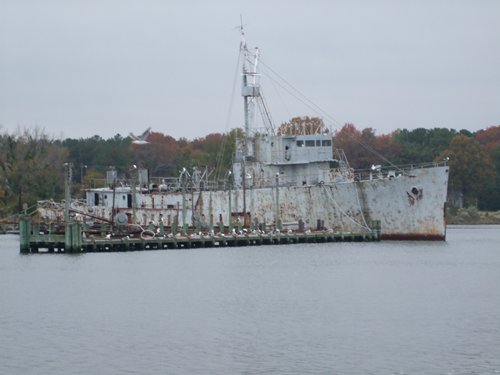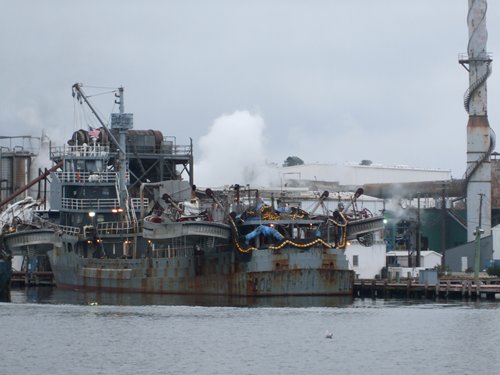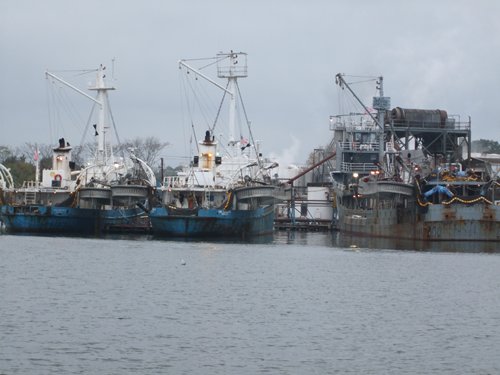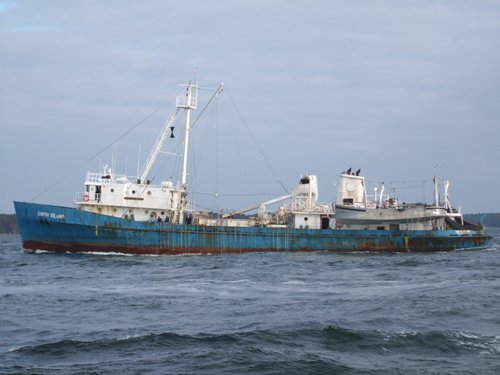Menhaden - who has heard of them? We hadn't!

AJAYA'S CRUISE
Phil & Nikki Hoskins
Sat 31 Oct 2009 17:26
|
37:50.41N, 76:16.45W
Our first stop after Solomons Island was Reedville,
a place we had by-passed on the way north earlier in the year. In fact a lot of
cruisers by-pass Reedville whichever direction they are heading. Why? Because of
the fish processing factory that 'guards' the entrance to the pretty
locality of Cockrell Creek. The smell emanating from this processing
plant could bring down a buffalo, not that buffalos are thick on the
ground in these parts.
As we entered the Great Wicomico River, which is on
Virginia's northern neck, we could see the pall of steam rising from the one
remaining plant which is all that's left from what was a massive industry in the
past. This remaining factory looks like some Heath Robinson invention
taken to extremes, with cylinders, pipes and chimneys dotted over the area all
seemingly joined up somehow. Alongside the dock were 9 or 10 100' long
fishing vessels all looking in urgent need of some new paint. As we entered
the creek, having been greeted by some very large dolphins (who obviously
love the smell) we came into direct downwind line with the stream of tainted air
wafting from the factory. In the surrounding area could be seen remnants of
other factories, all now in ruins.
  Our escort arrives to guide us into the Great
Wicomico
river
Approaching the fish factory
  The glory days are behind this rotting relic of
the
past
.....which is moored alongside one of the now derelict processing
plants
  These don't look in much better
condition
...... but they are still plying their
trade
So what exactly are menhaden we wondered. We
thought we knew most of the major fish species but these were new to us. As
always the guide books and internet prove to be a major source of information
about these small silvery swimmers and their place in the
food chain although menhaden are never directly eaten by humans - they are far
too oily, boney and smelly, even before processing begins! But they are found in
numbers too large to count in this part of the bay. A shoal can be the size of a
football pitch and reach to a 100' depth. That's a lot of fish. The fishing
fleet rely on the support of a spotter plane flying over the area which reports
on the position of any large menhaden shoals. The fleet then heads at full speed
to the shoal and releases smaller 40' long skiffs with purse seine nets
that surround the shoals, pulling the nets round to gather up the maximum number
of fish, which are then literally sucked into the holds of the parent
vessel by giant vacuum pipes. Then its back to the factory to offload the
catch which is processed into all manner of useful products - chicken feed, fish
food and even linoleum. Taking human intervention apart, menhaden form a
valuable stage in the food chain providing huge pickings for many of the
voracious surface feeders, including gulls, ospreys, pelicans etc. And of
course waiting for all the scraps to float down into the depths are the crabs.
So in a way, whilst humans don't eat the menhaden directly, we do indirectly via
the food chain we are all part of. (Vegetarians apart!).
Having survived the overwhelming assault on our
noses we anchored for the night in the tranquillity of a pretty creek surrounded
by beautiful houses. Hard to believe that such opulent property exists within
half mile of one of the smelliest factories imaginable. We did wonder if the
richer residents had property at each end of the creek and lived in the upwind
house dependant on prevailing wind direction to breath good fresh
air.
  Peace, tranquillity - with no
smell .....Reedville
Reedville was a one night stop as the forecast was
fine to continue southwards the following morning. But there is much to see here
and we will brave the plant's output next summer for a better look at the town
and it's factory. Besides there is a museum and model railway to be
viewed.
Leaving the following morning we motored as quickly
as possible out of the creek and out towards the bay, where we were faced with
the returning fleet, motoring at full speed back to the factory. This had the
effect of causing standing waves that pitched us up and down like laundry in a
washing machine. Once all nine ships had raced past, the sea settled a little as
we sailed sedately off in the direction of Deltaville, our next
stop.
  The
returning fleet
one of the aluminium 'purse seiner' skiffs is winched onboard
aft
|